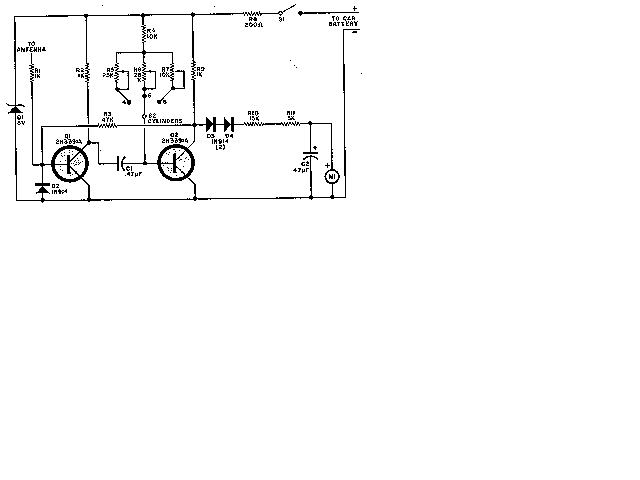
Anyone performing their own automobile tune-ups knows how important it is to know your engines speed. With this tachometer, you can measure your engines speed without any connections or annoying timing lights.

PC board layout and parts placement
C1___________0.47uf Capacitor
C2___________47uf Electrolytic Capacitor
D1___________8v 1w Zener Diode
D2,D3,D4_____1N914 Diode
M1___________200ua Meter
Q1,Q2________2N3391A Transistor
R1,R2,R9_____1k 1/2 W Resistor
R3___________47k 1/2 W Resistor
R4___________10k 1/2 W Resistor
R5,R6________25k Trim Pot
R7___________10k Trim Pot
R8___________200 Ohm 2 W Resistor
R10__________15k 1/2 W Resistor
R11__________2.2k 1/2 W Resistor
S1___________SPST Togglae Switch
S2___________Three Position Single Pole Rotary Switch
MISC.________Telescoping Radio Antenna, Enclosure, Power Cable
and Battery Connector.
1. Calibrate the unit as folows:
a. Set up this circuit:
b. Turn on the Tach and allow a few minutes for temperature stabilization.
c. Set S2 to 4 cylinders and adjust R5 for a meter indication of 180 (1800 rpm).
d. Set S2 to 6 cylinders and adjust R6 for a meter indication of 120 (1200 rpm).
e. Set S2 to 8 cylinders and adjust R7 for a meter indication of 90 (900 rpm).
2. To use the Tach, turn it on and let it sit for one minute to allow for temperature stabilization. Extend the antenna, select the right number of cylinders and hold the unit over the engine. If the reading is erratic or the needle jumps around, move the antenna closer to the ignition coil or spark plug wires.
3. The unit draws power from the car battery. If it is connected backwards, it will not work, but it won't be damaged.